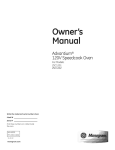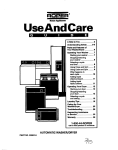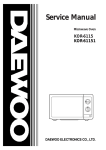Download Daewoo KOG-875T Service manual
Transcript
S/M No. : G875T2S001 Service Manual Microwave Oven Model: KOG-875T2S DAEWOO ELECTRONICS CO., LTD. http : //svc.dwe.co.kr Feb. 2002 PRECAUTIONS TO BE OBSERVED BEFORE AND DURING SERVICING TO AVOID POSSIBLE EXPOSURE TO EXCESSIVE MICROWAVE ENERGY (a) Do not operate or allow the oven to be operated with the door open. (b) Make the following safety checks on all ovens to be serviced before activating the magnetron or other microwave source, and make repairs as necessary: (1) Interlock operation, (2) proper door closing, (3) seal and sealing surfaces (arcing, wear, and other damage), (4) damage to or loosening of hinges and latches, (5) evidence of dropping or abuse. (c) Before turning on microwave power for any service test or inspection within the microwave generating compartments, check the magnetron, wave guide or transmission line, and cavity for proper alignment, integrity, and connections. (d) Any defective or misadjusted components in the interlock, monitor, door seal and microwave generation and transmission systems shall be repaired, replaced, or adjusted by procedures described in this manual before the oven is released to the owner. (e) A microwave leakage check to verify compliance with the Federal Performance Standard should be performed on each oven prior to release to the owner. TABLE OF CONTENTS PROPER USE AND SERVICE PRECAUTIONS .......................................................................................................................2 SPECIFICATIONS.......................................................................................................................................................................3 EXTERNAL VIEWS.....................................................................................................................................................................3 NAMES AND FUNCTION OF PARTS........................................................................................................................................4 CONTROL PANEL ......................................................................................................................................................................5 INTERLOCK MECHANISM FUNCTIONS AND ADJUSTMENTS .............................................................................................6 PRECAUTIONS FOR DISASSEMBLY AND REPAIR ...............................................................................................................8 DISASSEMBLY AND ASSEMBLY..............................................................................................................................................9 TROUBLE SHOOTING GUIDE ................................................................................................................................................17 MEASUREMENT ......................................................................................................................................................................23 COMPONENT TEST PROCEDURE ........................................................................................................................................25 WIRING DIAGRAM ...................................................................................................................................................................26 SCHEMATIC DIAGRAM ...........................................................................................................................................................27 EXPLODED VIEWS AND PARTS LIST ...................................................................................................................................29 PRINTED WIRING BOARD ......................................................................................................................................................32 P.C.B. CIRCUIT DIAGRAM ......................................................................................................................................................37 P.C.B. ASS’Y PART LIST .........................................................................................................................................................38 1 PROPER USE AND SERVICE PRECAUTIONS 1. For Safe Operation Damage that allows the microwave energy (that cooks or heats the food) to escape will result in poor cooking and may cause serious bodily injury to the operator. IF ANY OF THE FOLLOWING CONDITIONS EXIST, OPERATOR MUST NOT USE THE APPLIANCE. (Only a trained service personnel should make repairs.) 1) A broken door hinge. 2) A broken door viewing screen. 3) A broken front panel, oven cavity. 4) A loosened door lock. 5) A broken door lock. The door gasket plate and oven cavity surface should be kept clean. No grease, soil or spatter should be allowed to build up on these surfaces or inside the oven. DO NOT ATTEMPT TO OPERATE THIS APPLIANCE WITH THE DOOR OPEN. The microwave oven has concealed switches to make sure the power is turned off when the door is opened. Do not attempt to defeat them. DO NOT ATTEMPT TO SERVICE THIS APPLIANCE UNTIL YOU HAVE READ THIS SERVICE MANUAL. 2. For Safe Service Procedures. 1) This microwave oven weight 17.6kg (38.9 lbs.) and must be placed on a horizontal base strong enough to support this weight. 2) The oven should be placed as far from high temperature source and vapour as possible. 3) The power supply cord is about 1.1m (3.2ft) long. Earthing is required when connecting the power source. 4) Maximum power consumption of this oven is approximately 2.5Kw(230V). It is suggested that the unit is operated on such power line (about 13 amperes) that can provide more power than this rating. 5) Object must not be placed on the top enclosure so as not to obstruct air flow for ventilation. WARNING : This appliance must be earthed. IMPORTANT The wires in this mains lead coloured in accordance with the following code. Green-and-yellow : Earth Blue : Neutral Brown : Live As the colours of the wires in the mains lead of this appliance may not correspond with the coloured markings identifying the terminals in your plug, proceed as follows: The wire which is coloured green-and-yellow must be connected the the terminal in the plug which is marked with the letter ‘E’ or by earth symbol or green-and-yellow. The wire which is coloured blue must be connected to the terminal which is marked with the letter ‘N’ or coloured black. The wire which is coloured brown must be connected to the terminal which is marked with the letter ‘L’ or coloured red. NOTE : This oven is designed for counter-top use only. 2 SPECIFICATIONS POWER SUPPLY 230V ~ , 50Hz single phase with earthing MICROWAVE POWER CONSUMPTION 1,400 W OUTPUT POWER 900 W (IEC 705) FREQUENCY 2,450 MHZ GRILL POWER CONSUMPTION 1,400 W COMBINATION HEATING POWER CONSUMPTION 1,400 W OUTSIDE DIMENSIONS (W X D X H ) 501 X 320 X 413 mm (19.7 X 12.6 X 16.2 in.) CAVITY DIMENSIONS (W X D X H) 310 X 229 X 320 mm (12.2 X 9.0 X 12.6 in.) NET WEIGHT 17.6 kg (38.9 Ibs.) TIMER 60 minutes SELECT FUNCTION Microwave/Grill /Combination Heating MICROWAVE POWER LEVEL 10 stages * Specifications subject to change without notice. EXTERNAL VIEWS 501 413 DEFROST GRILL COMBI WEIGHT-TIME M/W GRILL KG WEIGHT TIME DEFROST DEFROST COMBI +1MIN PROGRAM COOK 1. Roast Beef 2. Roast Port 3. Roast Chicken 4. Fish Fillets 5. Vegetable 320 M/W PROGRAM COOK SPEEDY COOK STOP/CLEAR START/CLOCK Fig. 1 Front View Fig. 2 Side View 3 NAMES AND FUNCTION OF PARTS 1 2 6 3 4 5 DEFROST M/W GRILL COMBI WEIGHT-TIME PROGRAM COOK M/W GRILL KG TIME WEIGHT DEFROST DEFROST COMBI +1MIN PROGRAM COOK 1. Roast Beef 2. Roast Port 3. Roast Chicken 4. Fish Fillets 5. Vegetable SPEEDY COOK STOP/CLEAR START/CLOCK 7 8 9 1 Door latch When the door is closed it will automatically lock shut. If the door is opened while the oven is operating. The magnetron will automatically shut off. 6 Heater Grill or Combi-Mode has need for the heater. 7 Class cooking tray Made of special heat resistant glass. The tray must always be in proper position before operating. Do not cook food directly on the tray. 2 Door seal The door seal maintains the microwave within the oven cavity and prevents microwave leakage. 3 Oven cavity 8 Roller guide Supports the glass cooking tray. 4 Spatter shield Protects the microwave outlet from splashes of cooking foods. 9 Door screen Allows viewing of food. The screen is designed so that light can pass through, but not the microwaves. 5 Safety interlock system Prevents the oven from operating while the door is opened. 4 CONTROL PANEL When blinking, the oven is operating in WEIGHT DEFROST. When blinking, the oven is operating in COMBI cooking. When blinking, the oven is operating in GRILL cooking. DEFROST When blinking, the oven is operating in MICROWAVE cooking. When blinking, the oven is operating in PROGRAM cook. Microwave Power Level Used to select the variable microwave power level. If this button is pressed for more than 1.3 seconds, number is scrolled up automatically. M/W GRILL COMBI WEIGHT-TIME PROGRAM COOK M/W GRILL When blinking, the oven is operating in TIME DEFROST. When blinking, the oven is operating in weight input mode. KG WEIGHT TIME DEFROST DEFROST +1MIN COMBI When you touch this button, Cooking time is increased by the step of 1 minute. PROGRAM COOK 1. Roast Beef 2. Roast Pork 3. Roast Chicken 4. Fish Fillets 5. Vegetable Function Button - Used to select desired oven operation. M/W MICROWAVE GRILL SPEEDY COOK WEIGHT DEFROST COMBI TIME DEFROST DIAL KNOB - Used to enter the cooking time and weight input. +1 MIN PROGRAM COOK STOP/CLEAR START/CLOCK Stop/Clear Button - Used to pause or clear all information manually put into the oven. GRILL WEIGHT DEFROST COMBINATION TIME DEFROST +1 MIN PROGRAM COOK Speedy Cook Button Used to quickly program cooking time in 30 seconds increments. Start/Clock Button Used to start operation and to set the clock. 5 INTERLOCK MECHANISM FUNCTIONS AND ADJUSTMENTS The door lock mechanism is a device which has been specially designed to completely eliminate microwave radiation when the door is opened during operation, and thus to perfectly prevent the danger resulting from the leakage of microwave. (1) Primary interlock switch When the door is closed, the hook locks the oven door. If the door is not closed properly, the oven will not operate. When the door is closed, the hook pushes the lever downward. The lever press the button of the primary interlock switch to bring it under ‘ON’ condition. Mounting screw Hook Primary interlock switch 6 (2) Monitor interlock switch When the door is closed, the hook pushes the lever forward, and pushes the Latch Lever downward the lever press the button of the interlock monitor switch to bring it under ‘OFF’ condition. The latch Lever press the button on the secondary interlock switch to bring it under ‘ON’ condition. - Adjustment Interlock monitor switch When the door is closed, the monitor switch should be opened before other switches close. When the door is opened, the monitor switch should be closed after other switches open. Adjustment steps : a) Loosen the two mounting screws. b) Adjust the interlock switch assembly position. c) Make sure that the latch lever moves smoothly after adjustment is completed. d) Completely tighten the two mounting screws. 7 PRECAUTIONS FOR DISASSEMBLY AND REPAIR - Cautions to be observed when trouble shooting. Unlike many other appliances, the microwave oven is high-voltage, high-current equipment. It is completely safe during normal operation. However, carelessness in servicing the oven can result in an electric shock or possible danger from a short circuit. You are asked to observe the following precautions carefully. (1) Always remove the power plug from the outlet before servicing. (2) Use an insulated screwdriver and war rubber gloves when servicing the high voltage side. (3) Warning about the electric charge in the high voltage capacitor. When inspecting and repairing the high voltage side, always short the capacitor terminals and make sure of discharge. 1. Check the earthing. Do not operate on a 2-wire extension cord. The microwave oven is designed to be used when earthed. It is imperative, therefore, to makes sure it is earthed properly before beginning repair work. 2. Warning about the electric charge in the high voltage capacitor. For about 30 seconds after the operation stops, electric charge remains in the high voltage capacitor. When replacing or checking parts, short between oven chassis and the negative high terminal of the high voltage capacitor, by using a properly insulated screw driver to discharge. (4) When the 15 Amp fuse (normal blow type) is blown out due to the operation of the monitor switch; replace primary, secondary interlock switch and monitor switch. Refer to 7 page for the necessary adjustment. (5) After repair or replacement of parts, make sure that the screws are properly tightened and all electrical connections are tightened. (6) Do not operate without cabinet. CAUTION : Service personnel should remove their watches whenever working close to or repairing the magnetron. WARNING : When servicing the appliance, need a care of touching or replacing high potential parts because of electrical shock or exposing microwave. These parts are as follows - H.V. Transformer, magnetron, H.V. Diode, H.V. Capacitor. 8 DISASSEMBLY AND ASSEMBLY 1. To remove cabinet. (Refer to Fig. 1) 1) Remove three screws on cabinet back. 2) Push the cabinet backward. Fig. 1 2. To remove guide wind assembly. (Refer to Fig. 2) 1) Release two screws 2. 2) Remove back-cover 3. 3) Pull the fan 5 to the motor shaft. 4) Release two screws 1 which secure the motor shaded pole 4. 5) Reverse the above steps for reassembly. 2 1 5 4 3 9 Fig. 2 3. To remove H.V. transformer. (Refer to Fig. 3) 1) Remove four screws 1 which secure the H.V. Transformer bracket to the base plate. 2 2) Remove the H.V. Transformer 2. 1 Fig. 3 High voltage circuit wiring Mognetron H.V. Copacitor H.V.Diode H.V. Trans H.V.Fuse 10 4. To remove magnetron. (Refer to Fig. 4) 1) Remove a screw 2 which secure the magnetron 1. 2) Remove the magnetron. 3) Reverse the above steps for reassembly. Fig. 4 CAUTION : Never install the magnetron without the metallic gasket plate which is packed with each magnetron to prevent microwave leakage. Whenever repair work is carried out on magnetron, check the microwave leakage. It shall not exceed 4mW/cm2 for a fully assembled oven with door normally closed. Magnetron antenna Metallic gasket plate Wave guide Magnetron antenna Cooling fin Filament terminal Metallic gasket plate <Magnetron> 11 5. To remove control panel assembly. (Refer to Fig. 5, 6) (1) Remove a screw holding control panel assembly to the oven front plate. At the same time, draw forward the control panel assembly from oven front plate. (2) Remove the Dial knob. (3) Remove nine screws which secure the main and sub PCB assembly to control panel. (4) Remove buttons. Fig. 5 (5) Remove the Window display and Decorator Panel. B01 B05 B11 B02 B10 B03 B09 B06 B08 B07 B04 Fig. 6 REF NO. PART CODE B01 3516716350 PART NAME DESCRIPTION CONTROL-PANEL ABS XR-401 Q’TY 1 B02 3511602520 DECORATOR C-PANEL STS304 T0.6H/L 1 B03 3515501310 WINDOW DISPLAY PMMA 1 B04 3513404620 KNOB VOLUME ABS XR-401 1 B05 3516905120 BUTTON FUNCTION ABS XR-401 1 B06 3516907200 BUTTON FUNCTION ABS XR-401 1 B07 3516906320 BUTTON FUNCTION ABS XR-401 2 B08 PKBPMSYB00 PCB SUB AS KOC-984T1S 1 B09 7621301011 SCREW TAPPING T2S PAN 3X10 PW MFZN 6 B10 PKMPMSVG10 PCB MAIN AS KOG-875T2S 1 B11 7122401211 SCREW TAPPING T2S TRS 4X12 MFZN 4 12 REMARK 6. To remove door assembly. (Refer to Fig. 7) 1 1) Remove two screws 1 which secure to hinge. 2 2) Remove door assembly 2. 3) Remove door above for reassembly taking case to replace fixing glue. 7. To remove door part. (Refer to Fig. 8) Fig. 7 (1) Remove the Gasket door (2) Remove the Door seal Ass’y. (3) Remove the Hook and Spring. (4) Remove the Barrier Screen. (5) Remove a screw holding the handle. (6) Remove the Handle form the Frame door. A10 A08 A09 A07 A05 A11 A01 A12 A06 A02 A03 Fig. 8 A04 REF NO. PART CODE PART NAME DESCRIPTION A01 3511604200 DECORATOR DOOR *T STS304 T0.6 H/L 1 A02 3511604300 DECORATOR DOOR *U STS304 T0.6 H/L 1 A03 3512602600 HANDEL DOOR *T STS304 T0.6 H/L 1 A04 3512602700 HANDLE DOOR *U ABS XR-401 1 A05 3512203590 FRAME DOOR ABS XR-401 1 A06 7122401211 SCREW TAPPING T2S TRS 4X12 MFZN 2 A07 3517004580 BARRIER-SCREEN *O TEMPERED GLASS T3.2 1 A08 3515203600 STOPPER HING *T AS KOC-970T1S 1 A09 3511709000 DOOR SEAL AS KOC-871C0S 1 A10 3512301310 GASKET DOOR PP 1 A11 3513101300 HOOK POM 1 A12 3515101300 SPRING HOOK PW1 1 13 Q’TY REMARK 8. Method to reduce the gap between the door seal and the oven front surface. (1) To reduce gap located on part ‘A’. 1) Remove the cabinet. 2) Loosen a screw on top door hinge, then push the door to contact the door seal to oven front surface. 3) Tighten a screw. A C DEFROST M/W GRILL COMBI WEIGHT-TIME PROGRAM COOK M/W GRILL KG WEIGHT TIME DEFROST DEFROST COMBI +1MIN PROGRAM COOK 1. Roast Beef 2. Roast Port 3. Roast Chicken 4. Fish Fillets 5. Vegetable SPEEDY COOK STOP/CLEAR B START/CLOCK D 2) To reduce gap located on part ‘B’. 1) Loosen a screw on bottom hinge, then push the door to contact the door seal to oven front surface. 2) Tighten a screw. (3) To reduce gap located on part ‘C’. 1) Remove the cabinet. 2) Loosen a screw on interlock switch assembly located bottom of oven body. 3) Draw the interlock switch assembly inward as possible to engage with hook on the door bottom. 4) Tighten a screw. (4) To reduce gap located on part ‘D’. 1) Remove the cabinet. 2) Loosen a screw on interlock switch assembly located top of oven body. 3) and 4) are same as step (3). NOTE : Small gap may be acceptable if the microwave leakage does not exceed 4mW/cm2. NOTE : The door on a microwave oven is designed to act as an electronic seal preventing the leakage of microwave energy from the oven cavity during the cook cycle. This function does not require that the door be air-tight, moisture (condensation) - Tight or light-tight. Therefore, the occasional appearance of moisture, light or the sensing of gentle warm air movement around the oven door is not abnormal and do not of themselves, indicate a leakage of microwave energy from the oven cavity. If such were the case, your oven could not be equipped with a vent, the very purpose of which is to exhaust the vapor-laden air from the oven cavity. 14 9. To remove tray motor and under Heater. (Refer to Fig. 9) 1) Cut the tray motor cover parts from the base plate (Refer to Fig. 9). 2) Remove two screws 2 which secure the tray motor 1. 1 2 CUTTING(8EA) Fig. 9 15 10. To remove grill heater assembly. (Refer to Fig. 10) 2 3 1 4 Fig. 10 1) Remove the cabinet. 2) Release two screws 1 , and remove the Top cover 2. 3) Release a screws 3 , and remove Air Guide outlet 4. 4) Release grill Heaters Bracket 5. 5) Release the above steps for reassembly. 16 TROUBLE SHOOTING GUIDE Following the procedure below to check if the oven is defective or not. 1. Check earthing before trouble checking. 2. Be careful of the high voltage circuit. 3. Discharge the high voltage capacitor. 4. When checking the continuity of the switches, fuse or high voltage transformer, disconnect one lead wire from these parts and check continuity with the AC plug removed. To do otherwise may result in a false reading or damage to your meter. NOTE : When electric parts are checked, be sure the power cord is not inserted the wall outlet. Check wire harness, wiring, and connected of the terminals, and power cord before check the parts listed below. (TROUBLE 1) Oven does not operate at all ; any inputs can not be accepted. Condition Fuse blows Check Result Check continuity of interlock monitor switch with door closed (COM ↔ NC) (COM ↔ NC) Continuity Cause Remedy Malfunction of interlock monitor switch Replace Malfunction of interlock switch Replace Shorted contacts of primary interlock switch. Replace Defective low voltage transformer Replace Defective high voltage transformer Replace Note 1. (COM ↔ NC) No Continuity No Continuity Check continuity of both primary and secondary interlock switch with door closed Note 1. Continuity Continuity Check continuity of primary interlock switch contact with door partially open until interlock monitor switch contact close (COM NC close) 0 Ω or infinite Check continuity of primary winding of low voltage transformer Note 1. Approx. 150~210 (normal) Disconnect high voltage fuse and operate the unit Fuse again blows 17 Condition Outlet has proper voltage. Fuse does not blow. Check Result Cause Remedy Check continuitymagnetron No Continuity Defective magnetron Check continuity of noise filter board No Continuity Defective line filter board Replace Check continuity of power supply cord No Continuity Open power supply cord Adjust. Normal Defective touch control circuit Adjust. Replace NOTE1 : All these switches must be replaced at the same time, please refer to page7 for adjustment instructions (TROUBLE 2) Condition Grill heater is not heated Grill Heater (Top heater) does not heat (Food will not become hot). Check Result Cause Check continuity of primary interlock switch No Continuity Malfunction of Primary Interlock Switch Adjust or replace Check continuity of secondary interlock switch No Continuity Malfunction of secondary interlock switch Adjust or replace Check continuity of heater No Continuity Defective heater Replace Defective touch control circuit Replace Check D.C. voltage being supplied to RELAY (RY2) coil 0V Approx. 12VDC 18 Faulty contacts of RELAY (RY2) or open relay coil Remedy Replace (TROUBLE 3) Condition No microwave oscillation No microwave oscillation even though fan motor rotates. Check Check continuity of high voltage fuse Result Cause Remedy No Continuity Replace high voltage fuse Check continuity of high voltage capacitor terminals with wires removed Continuity Defective high voltage transformer Replace Continuity in backward direction Defective high voltage rectifier Replace Connect megger leads to magnetron terminal and magnetron body Continuity Defective magnetron Replace Check resistance of primary and secondary coil of high voltage transformer 0 Ω or ∞ Defective high voltage transformer Replace Check continuity of magnetron with wires removed No Continuity Defective magnetron Replace Check continuity of filament terminal of high voltage transformer No Continuity Defective high voltage transformer Replace Check continuity of microwave select switch No Continuity Defective timer ass’y Replace Check D.C. voltage being supplied to RELAY (RY1) coil 0V Defective touch control circuit Replace Approx. 12VDC Faulty contacts or RELAY (RY1) or open relay coil Replace Check continuity of high voltage rectifier in forward and backward direction with DC megger 19 (TROUBLE 4) Display shows all figures selected, but oven does not start cooking, even though desired program and time are set and start pad is tapped. Condition Turn table motor, and oven lamp do not turn on Check Check continuity of primary interlock switch Check continuity of secondary interlock and D.O.M. switch Result Cause No Continuity Malfunction of Primary interlock switch Adjust or replace Malfunction of secondary interlock and D.O.M. switch Adjust or replace No Continuity Check D.C. voltage being supplied to RELAY "3" coil. 0V Approx. 12VDC 20 Defective touch control circuit Faulty contacts of RELAY "3" or open relay coil Remedy Replace Replace (TROUBLE 5) The following visual conditions indicate a probable defective touch control circuit or membrance switch assembly 11. Incomplete segments, (A) Segments missing. (B) Partical segments missing. (C) Digit flickering other than normal fluorescent slight flickering. (D) 0 does not display when power is on. 12. A distinct change in the brightness of one or more numbers is the display. 13. One or more digits in the display are not on when they should be. 14. Display indicates a number different from one touched. 15. Specific numbers (for example 2 or 3) will not display when the panel is touched. 16. Display does not count down or up with time cooking or clock operation. 17. Oven is programable and cooks normally but no display shows. 18. Display obviously jumps in time while counting down. 19. Display counts down noticeably too fast while cooking. 10. Display does not show the time of day when clear pad is touched. 11. Oven lamp and turntable motor do not stop although cooking is finished. Check if the RELAY "4" contacts close if they are close, replace touch control circuit. DEFROST M/W GRILL COMBI WEIGHT-TIME PROGRAM COOK KG Condition Check Result Cause Remedy Display does not show programming at all, even if keyboard is touched. Check each button for continuity of the button keyboard for the following keyboard check procedure Normal Malfunction of touch control circuitry of control box sub-assembly Replace control box subassembly Abnormal Malfunction of the button keyboard Replace the button keyboard NOTE1 : Before following the particular steps listed above in the trouble shooting guide for the button keyboard's, failure, please check for the continuity of each wire-harness between the button keyboard and P.C.B. assembly. 21 BUTTON KEYBOARD CHECK PROCEDURE 1. Type of encoding and button names. 2 3 4 5 TIME DEFROST 53 8 8 52 6 6 51 4 4 50 2 2 R12 100K C2 102 RA3 RGLD7X104J 10 12 14 15 10 12 14 15 GRILL SPEEDY COOK WEIGHT DEFROST M/W +1min COMBI CN101 HLEM15R-1 PROGRAM COOK START STOP CLEAR TACK SWITCH KPT-1115AMX10 CA1 B7102M Fig. 11 Key Matrix and circuit diagram The button keyboard consists of 12 keys whose configurations are described above and provides 8 pad terminations to be connected to the touch control circuit as in Fig. 11. 2. Key check procedure. To determine if the button keyboard is defective or not, check the continuity of each button (Key) contacts with a multimeter. 11) PROGRAM COOK 12) WEIGHT DEFROST 13) MICROWAVE 14) COMBI 15) GRILL 16) +1 MIN 17) TIME DEFROST 18) STOP/CLEAR 19) START/CLOCK 10) SPEED COOK button : Between 4 and 15 button : Between 8 and 14 button : Between 8 and 15 button : Between 6 and 15 button : Between 8 and 12 button : Between 6 and 14 button : Between 8 and 10 button : Between 2 and 14 button : Between 2 and 12 button : Between 6 and 10 22 MEASUREMENT 1. Microwave Output Power CAUTION : 1. Water load should be measured exactly to 1 liter. 2. Input power voltage should be exactly volts as specified. 3. Ambient temperature should be 20 2 (68 3.6 ) 1-1. Standard Method Microwave output power can be checked by indirectly measuring the temperature rise of a certain amount of water exposed to the microwave as directed below. 1) Microwave power output measurement is made with the microwave oven supplied at rated voltage and operated at its maximum microwave power setting with a load of 1,000 ± 5cc of potable water. 2) The water is contained in a cylindrical borosilicate glass vessel having a maximum material thickness of 3 mm and an outside diameter of approximately 190 mm. 3) The oven and the empty vessel are at ambient temperature prior to the start of the test. The initial temperature prior to the start of the test. The initial temperature of the water is 10 ±2˚C (50 ± 3.6˚F) It is measured immediately before the water is added to the vessel. After addition of the water to the vessel, the load is immediately placed on the center of the shelf which is in the lowest normal position. (fig. 12). 4) Microwave power is switched on. 5) Heating time should be exactly 46 seconds. Heating time is measured while the microwave generator is operating at full power. 6) The initial and final water temperatures are selected so that the maximum difference between the ambient and final water temperatures is 5K. 7) The microwave power output P in watts is calculated from the following formula : P=4187 2. Electrical Continuity Check of Interlock Switch 2-1. Procedure NOTE : Remove the power plug from the wall receptacle before testing. 1) Primary Interlock Switch 1) Disconnect two connector from Primary Interlock Switch. 2) Connect the ohm-meter leads between the terminals of the primary interlock switch. 3) Read the value of resistance between the terminals of the switch, when the door is opened, and when the switch, when the door is opened, and when the door is closed. 2) Secondary Interlock Switch 1) Disconnect two connector from secondary interlock switch. 2) Connect the ohm-meter leads between the terminals of the secondary interlock switch. 3) Read the value of resistance between the terminals of the switch, when the door is opened, and when the oven door is closed. △T/t • △ T is actual temperature rise. • t is the heating time. The power measured should be 900W ±10% 3) Interlock Monitor Switch Water Load 1) Disconnect the lead wire connecting the primary interlock switch and interlock monitor switch from primary interlock switch terminal. 2) Connect the ohm-metor leads between the lead wire connector disconnected as item '1' and the power supply natural plug pin. 3) Read the value of resistance between the lead wire connector and the power supply natural plug pin, when the oven door is opened, and when the oven door is closed. Tray Fig. 12 23 2-2. Judgement The value of resistance should be applied to the value specified below. Door Open Closed Primary Interlock Switch 0 Secondary Interlock Switch 0 Interlock Monitor Circuit 3-3. Procedures 1) Prepare 600cc glass or plastic container. 2) Pour 275±15 milliliters of tap water initially at 68±9˚F (20±5˚C) in the container. 3) Place it at the center of the tray and set it is a cavity. 4) Operate oven. 5) Measure the microwave leakage using a Narda 8100 or similarly approved microwave leakage meter after a few minutes operation. 0 3. Microwave Leakage Test NOTE : The scan rate should not exceed 1 inch/sec. 3-1. Warning 1) DO NOT place your hands into any suspected microwave leakage field unless the safe density level is known. 2) Always start measuring of an unknown field to assure safety for operating personnel from microwave energy. 3) Slowly approach the unit under test until the radiometer reads and appreciable leakage from the unit under test. 4) Care should be taken not to place the eyes in direct line with the source of microwave energy. 3-2. Method The power density of the microwave leakage emitted by the microwave oven should not exceed 1mW/cm2 at any point 50mm (2 in). or more away from the external surface of the oven as measured prior to acquisition by a purchaser and there after once the oven is in use, 4mW/cm2 at any point 50mm (2 in) or more away from the external surface of the oven, checks to be made around the whole of the door seal and on each of the main unit surface. Measurements should be made with the oven operating at its maximum output and containing a load of 275 ±15 milliliters of tap water initially at 68±9 ˚F (20±5 ˚C) placed within the cavity at he center of the load carrying surface provided by the manufacture. The water container should be a low from 600 milli-liters beaker having an inside diameter of approximately 85mm (3-11/32 in.) and made of an electrically nonconductive material such as glass or plastic. Fig. 13 24 COMPONENT TEST PROCEDURE 1. High voltage is present at the high voltage terminal of the high voltage transformer during any cook cycle. 2. It is neither necessary nor advisable to attempt measurement of the high voltage. 3. Before touching any oven components or wiring, always unplug the oven from its power source and discharge the capacitor (see page 8). 1. High voltage transformer 4. Magnetron (A) Remove connections from the transformer terminals and check continuity. (B) Normal readings should be as follows: Secondary winding Approx. 90Ω ± 10% Filament winding Approx. 0Ω Primary winding Approx. 0Ω For complete magnetron diagnosis, refer to "Measurement of the Microwave Output Power". Continuity checks can only indicate and open filament or a shorted magnetron. To diagnose for an open filament or shorted magnetron. (A) Isolate magnetron from the circuit by disconnecting the leads. (B) A continuity check across magnetron filament terminals should indicate one ohm or less. (C) A continuity check between each filament terminal and magnetron case should read open. Filament terminal Primary terminal Metallic gasket plate Magnetron antenna Magnetron chassis ground Secondary terminal Cooling fin Filament terminal 2. High voltage capacitor A) Check continuity of capacitor with meter on the highest ohm scale. (B) A normal capacitor will show continuity for a short time, and then indicate 9MΩ once the capacitor is charged. (C) A shorted capacitor will show continuous continuity. (D) An open capacitor will show constant 9MΩ. (E) Resistance between each terminal and chassis should be infinite. 3. High voltage diode The high voltage diode is located on the base near the transformer. (A) Isolate the diode from the circuit by disconnecting the leads. (B) With the ohmmeter set on the highest resistance scale, measure the resistance across the diode terminals. Reverse the meter leads and again observe the resistance reading. Meter with 6V, 9V or higher voltage batteries should be used to check the front-to-back resistance may be read in both directions. A normal diodes resistance will be infinite in one direction and several hundred KΩ in the other direction. 25 WIRING DIAGRAM 26 SCHEMATIC DIAGRAM 27 28 EXPLODED VIEWS AND PARTS LIST 29 NO PART CODE A00 3511710030 B00 PKCPSWVG10 1 PART NAME DESCRIPTION Q'TY DOOR AS KOG-875T0S 1 CONTROL PANEL AS KOG-875T2S 1 3516108660 CAVITY AS KOG-87050S 1 2 3516503900 REAR PLATE *0 SBHG-1 T0.6 1 3 3511403800 COVER WAVE GUIDE MICA T0.35 1 4 7113400814 SCREW TAPPING T1 BIN 4X8 MFNI 1 5 3517203201 TRAY RACK AS KOG-84150S 104MM 1 6 3517400610 COUPLER TEFLON 1 7 3966030500 MOTOR SYNCRO 220/240V 4W GM-16-24FD016 1 8 7121400611 SCREW TAPPING T2S PAN 4*6 MFZN 2 9 3510311000 BASE SBHG-1 T0.8 1 10 3515202800 STOPPER HINGE *U AS KOR-121M0A 1 11 7272400811 SCREW TAPTITE TT3 TRS 4*8 MFZN 1 12 3512101400 FOOT DASF-310 4 13 4416W67820 CAPACITOR HV 2100VAC 1.1µF 1 14 3513001900 HOLDER HV CAPACITOR SECC T0.8 1 15 7272400811 SCREW TAPTITE TT3 TRS 4*8 MFZN 1 16 4416V24000 DIODE HV SANKEN HVR-1X-32B(D5.3) 1 17 3518605001 NOISE-FILTER DWLF-M05 1 18 3518700211 FUSE HV 5KV 0.7A 1 19 3511200400 CLAMP WIRE SBHG 1 20 7112401011 SCREW TAPPING T1 TRS 4X10 MFZN 1 21 3518112400 TRANS HV JY-N90S1-87T 1 22 3516003800 SCREW SPECIAL T2 FLANGE 5X8 MFAN 4 23 7112401011 SCREW SPECIAL T1 TRS 4X10 MFZN 5 24 3513805710 LOCK POM 1 25 3513601600 LAMP BL 240V 25W T25 C7A H187 1 26 4415A66910 SW MICRO V-531A-0F/ SZM-V16-FA-61 2 27 4415A17352 SW MICRO VP-533A-0F-SPNO #187 200G 2 28 3513701300 LEVER LOCK POM 1 29 7122401211 SCREW TAPPING T2S TRS 4*12 MFZN 2 30 7122401211 SCREW TAPPING T2S TRS 4*12 MFZN 1 31 3511405000 COVER INSUATOR *T SECC T0.5 1 32 3512803000 HEATER MIRACLON 115V 550W 1 33 7112401011 SCREW TAPPING T1 TRS 4X10 MFZN 2 34 3518002200 MAGNETRON 2M218H(MF)I 1 35 3516004000 SPECIAL SCREW T2 BOLT FLANGE 4*10 MFZN 1 36 3511800100 FAN P.P GF20 1 37 3511402500 COVER *B SBHG T0.8 1 38 39635113900 MOTOR SHADED PLE 230V 17W MW15CA-K02 1 39 7S312X40A1 SCREW SPECIAL T1 TRS 4X10 SE MFZN 2 40 7S101W4081 SCREW MACHINE PAN FLANGE 4X8 MFZN 2 30 NO PART CODE PART NAME DESCRIPTION 41 3512515500 GUIDE AIR OUTLET SA1D T0.5 1 42 7S427W40A1 SCREW SPECIAL TT2 HEX FG 4X10 SE MFZN 2 43 35113ACSJ5 CORD POWER AS 3X1.5 40X40 120-RTML 1 44 7122401011 SCREW TAPPING T2S TRS 4*10 MFZN 2 45 3518905000 THERMOSTAT OFF:100 ON:90 V#187 1 46 7121300611 SCREW TAPPING T2S PAN 3X6 MFZN 1 47 3510800800 CABINET PCM 0.6T 1 48 7112401011 SCREW TAPPING T1 TRS 4X10 MFZN 3 49 3512512910 GUIDE ROLLER AS KOR-121Q3A 1 50 3517200401 TRAY BORO-SI 810G 1 51 7112401011 SCREW TAPPING T1 TRS 4X10 MFZN 1 52 3517503000 PROTECTOR WIRE STS430 DIA:4 3 53 3517503100 PROTECTOR HEATER MICA MT56 T1.0 2 31 Q'TY PRINTED WIRING BOARD 1.CIRCUIT CHECK PROCEDURE 1) Low voltage transformer (DMR-984FS) check. The low voltage transformer is located on the P.C.B. Measuring condition: Input voltage: 230VAC/50Hz 1 6 Terminal Voltage 7 1-3 230.0V 6-7 9 VAC 7-8 9 VAC 9-10 2.3 VAC 8 9 3 5 10 NOTE 1 : Secondary side voltage of the low voltage transformer changes in proportion to fluctuation of power source voltage. NOTE 2 : The allowable tolerance of the secondary voltage is within ± 5% of nominal voltage. 2) Voltage Check • Key check point (1~5: Micom Pin, 6:Display Pin) NO. CHECK POINT REMARK 1 PIN 63, 64 +5VDC±5% 2 PIN 29, 32, 62 0V 3 PIN 28 +5VDC±5% 4 PIN 45 +5VDC 0V 5 T: 20 ms (50 Hz) T PIN 30, 31 5V 0V 6 PIN 1, 25 T=0.25us (4.0MHz) T 2.6VAC (Display filament voltage) • CHECK METHOD NO. CHECK POINT REMARK 1 +5VDC 2 +12 VDC Replace D7, D8, EC2, EC3, C14, C11 3 -24 VDC Replace D9, D10, EC4, EC5, C15 Replace Q3, ZD3, R26, C10 NOTE : The marks of the above corresponding voltages (+5, +12, -24VDC)are written on the PCB. Each measuring points must be measured with GND points. 32 3) Display problems NO CAUSE MEASUREMENT RESULT 2.6VAC REMEDY 1 Poor contact between P.C.B. and display filament. Check the voltage of display pin 1 & 25 Fix the pin 1 & 25 on the P.C.B. 2 The display has some trouble in its segment or gril. Refer to “The display trouble shooting data” below Replace P.C.B. assembly. 3 Loss vacumm in the display. Find white spot. Replace P.C.B. assembly. The display trouble shooting data. TROUBLE DISPLAY NAME & PIN NO. MICOM OUTPUT IN PIN NO. Grid 1 doesn’t come on. Grid 1 (G1), 4, 7 13 Grid 2 doesn’t come on. Grid 2 (G2), 10 16 Grid 3 doesn’t come on. Grid 3 (G3), 14 18 Grid 4 doesn’t come on. Grid 4 (G4), 17 17 Grid 5 doesn’t come on. Grid 5 (G5), 21 24 Segment “a” dosent come on from G1 to G5. Segment a, 23 26 Segment “b” dosent come on from G1 to G5. Segment b, 22 25 Segment “c” dosent come on from G1 to G5. Segment c, 20 23 Segment “d” dosent come on from G1 to G5. Segment d, 19 22 Segment “e” dosent come on from G1 to G5. Segment e, 18 21 Segment “f” dosent come on from G1 to G5. Segment f, 16 20 Segment “g” dosent come on from G1 to G5. Segment g, 15 19 Segment “h” dosent come on from G1 to G5. Lower bar h, 5 14 Segment “i” dosent come on from G1 to G5. Upper bar i 6, 8, 9 ,11 15 33 4) When there is no microwave oscillation. (1) When touching “M/W” button, oven lamp turns on. Fan motor and turntable motor rotate and cook indicator in display comes on. * Cause : Relay 1 (RY1) dose not operate. B A RY1 G5G-1A-DT MAGNETRON Q7 KRX106M 40 D6 1N4148 V2 CHECK METHOD POINT A B STAGE 5VDC GND RY1 “ON” RY1 “OFF” GND 12VDC (2) When touching “M/W” button, oven lamp dose not turn on. Turntable motor dose not rotate, but cook indicator in display comes on. * Cause : Relay 3 (RY3) dose not operate. B A RY3 CSII-12SH TRAY MOTOR LAMP Q6 KRC106M 41 D2 1N4148 V2 CHECK METHOD POINT A B STAGE RY3 “ON” RY3 “OFF” 5VDC GND GND 12VDC (3) When touching “M/W” button, oven lamp turns on. Fan motor dose not rotate, but cook indicator in display comes on. * Cause : Relay 4 (RY4) dose not operate. B A RY4 CSII-12SH FAN MOTOR Q5 KRC106M D3 1N4148 V2 34 42 CHECK METHOD POINT A B STAGE VDC GND RY4 “ON” RY4 “OFF” GND 12VDC 5) When there is not heater. When touching “TEMP COOK & COMBI” button, oven lamp turns on. Fan motor and turntable motor rotate and cook indicator in display comes on. * Cause : Relay 2 (RY2) dose not operate. B A RY2 G5G-1A-DT UPPERHEATER Q8 KRC106M D5 1N4148 39 V2 CHECK METHOD POINT A B STAGE RY2 “ON” RY2 “OFF” 5VDC GND 35 GND 12VDC 6) When the door is opened during operation, the count down timer does not stop. CN2 35313-0210 COM R28 4.7K R22 4.7K R23 330 1 2 NO 47 D.O.M R25 4.7K C12 104 C13 104 A R24 100K B V1 CHECK METHOD POINT A B OPEN CLOSED +5VDC GND STAGE DOOR OPENED DOOP CLOSED NOTE : Check the state of the secondary interlock switch. 7) When “ ” comes on display. D1 1N4148 1N4004 6 V1 B A R17 4.7K C7 473 C5 473 Q1 C3198 R16 4.7K C1 R15 4.7K 45 INT1 C5 102 R13 4.7K C D7 7 1N4004 8 D8 CHECK METHOD POINT WAVEFORM A B C +5V 0V T: 20ms (60 Hz) T=20ms (50Hz) T if clock does not keep exact time, you must check. Diode 1, transistor Q2. 36 RED WHITE BLUE 37 5 10 9 8 7 6 EC4 220uF 50V EC3 1000uF 35V C7 473 D1 1N4148M F1 D9 1N4004 D8 1N4004 D7 1N4004 FAN MOTOR CS11-12SH RY4 TRAY MOTOR, LAMP V2 F2 EC5 220uF 50V D10 1N4004 EC2 1000uF 35V 0V(GND) +5V +12V -24V V2 V3 V3 V3 V1 VOLTAGE SYMBOL ZD1 4.7V C15 104 R26 Q1 C3198 1.2K,1/4W R13 4.7K C11 104 V2 R16 4.7K KRC106M C14 104 Q5 Q6 KRC106M C6 473 R17 4.7K V2 D3 1N4148 V2 D2 1N4148 Q7 KRC106M Q8 KRC106M ZD3 5.6V V1 EC1 10uF 50V SJ2 SJ1 SJ6 SJ5 C5 102 1 2 ZD2 3.9V C10 104 D.O.M CN2 35313-0210 R15 4.7K Q3 C3198 V1 BZ1 BM-20K R4 100K V1 C12 104 R3 100K V1 R1 100K R21 10K C1 104 R2 100K CR1 4.0MHz C8 104 R18 510 V1 R24 100K R23 330 R5 1K V1 Q9 KRC106M Q2 A1270Y C9 104 C13 104 R22 4.7K R6 100K R7 10K KBR-4.0MKSTF R20 1K R19 200 R25 4.7K R28 4.7K V2 R27 1K VCC AVR INT1 56 57 58 59 60 31 X1 30 X0 28 RSTX 32 VSS 62 AVSS 29 MODA 54,55 64 63 45 47 61 1 33 34 44 49 48 38 50 51 52 53 2 3 4 5 25 26 22 23 24 V1 R8 10K R10 10K D11 1N4148 C2 102 R14 100K R12 100K V1 V1 RA3 V3 R9 1K R11 1K C4 102 C3 102 CA1 B7102M RA1 RGLD7X104J RGLD7X104J RA2 RGLD7X104J 5G l 13 1 11 2 4 6 8 f 2G e d c 1G b a 4G 3G g k,j,i,h CN3 515 80-15 13 1 11 2 4 6 8 4,7 5 6,8,9,11 10 14 15 16 17 18 19 20 21 22 23 a PIE F2 1 SW108 SPEEDY COOK/ SW103 l LVT1 DMR-984FS (230V/50Hz) 3 1 RY3 CS11-12SH D6 1N4148 V2 D5 1N4148 13 14 15 16 18 19 20 17 21 l BROWN YELLOW BLACK CN4 35328-0610 RY1 G5G-1A-DT MAGNETRON RY2 G5G-1A-DT UPPER HEATER 39 40 41 42 43 SVM-5SS13 f DP1 e f g b e c GRILL SW111 DEFROST SW110 STOP/ CLEAR SW106 TEMP COOK SW102 12 12 F1 25 14 M/W SW107 PROGRAM COOK SW105 COMBI SW101 14 SW109 ROTARY SWITCH SDB16PVB17F-1-2-36-36PC TACT SWITCH SKHV10910A START SW104 10 10 d d IC1 f b f b e g c e g c h i j j b e c a a d 1G 2G 3G 4G a f g l d l k l 5G MB89144(3)AP- 15 CN101 515 81-15 15 P.C.B CURCUIT DIAGRAM MAIN P.C.B. ASS’Y PART LIST NO. 1 NAME PCB MAIN SYMBOL SPECIFICATION PART CODE Q’TY M218 93X213 3514314980 1 M219 91.5X163 3514314990 1 3515600100 1 2 BUZZER BZ1 BM-20K 3 CONNECTOR WAFER CN2 35313-0210 4 CONNECTOR WAFER CN3 515 80-15 5 CONNECTOR WAFER CN4 6 CONNECTOR WAFER 7 30166M7020 1 Q4CW215SBD0 1 35328-0610 4CW3061MX0 1 CN101 515 81-15 4CW215RBD0 1 DIGITRON DP-1 SVM-5SS13 DSVM5SS13- 1 8 HOLDER VFD DPH PP DIR-9930 3513002000 1 9 IC MICOM IC1 MB89144P-252 141SC985T0 1 10 TRANS POWER LVT1 DMR-984FS 5EPV41305 1 11 SW RELAY RY1, RY2 G5G-1A-DT DC 12 5SC0101123 2 12 SW RELAY RY3, RY4 CSII-12SH 5SC0101128 2 13 RESONATOR CERA CR1 KBR-4.0MKSTF 5PKBR40MKS 1 14 C ELECTRO EC1 RS 50V 10µF CEXE1H100A 1 15 C ELECTRO EC2,EC3 RSS 35V 1000µF CEXF1V102V 2 16 C ELECTRO EC4,EC5 RSS 50V 220µF CEXF1H221V 2 17 TRANSISTOR Q1, Q3 KTC3198GR TZTC3198GR- 2 18 TRANSISTOR Q2 KTA1266Y TZTA1266Y- 1 19 TRANSISTOR Q5---Q9 KRC106M TZRC106M-- 6 20 C CERA AXIAL C1, C8~C15 H1KF 50V 0.1µF Z CCZF1H104Z 9 21 C CERA AXIAL C6, C7 H1KF 50V 0.047µF Z CCZF1H473Z 2 22 C CERA AXIAL C2~C5 H1KF 50V 1000pF K CCZF1H101Z 4 23 C ARRAY CA1 8P(7) 50V 100pF CN7XB-102M 1 24 DIODE SWITCHING D1~D3, D5, D6 1N4148M DZN4148M-- 5 25 DIODE SWITCHING D7~D10 1N4004A DZN4004A-- 4 26 R CARBON FILM R-1~R4,R12,R14,R24,R6 1/6W, 100K OHM J RD-AZ104J- 8 27 R CARBON FILM R5,R9,R11,R20,R27 1/6W, 1K OHM J RD-AZ102J- 5 28 R CARBON FILM R8,R10,R21,R7 1/6W, 10K OHM J RD-AZ103J- 4 29 R CARBON FILM R13,R15~R17,R22,R28 1/6W, 4.7K OHM J RD-AZ472J- 6 30 R CARBON FILM R18 1/6W, 510 OHM J RD-AZ511J- 1 31 R CARBON FILM R19 1/6W, 200 OHM J RD-AZ201J- 1 32 R CARBON FILM R23 1/6W, 330 OHM J RD-AZ331J- 1 33 R CARBON FILM R26 1/4W, 1.2K OJM J RD-4Z122J- 1 34 ARRAY RA1, RA2, RA3 8P(7) 1/8 100K J RA88X104J 3 35 DIODE ZENER ZD1 MTZ J 4.7B DZUZ4R7BSB 1 36 DIODE ZENER ZD2 MTZ J 3.9B DZUZ3R9BSB 1 37 DIODE ZENER ZD3 MTZ J 5.6B DZUZ5R6BSB 1 38 SW ROTARY SW109 SDB161PVB17F-1-2 5S10109002 1 -36-36PC(PITCH 5) 39 WIRE FLAT WF1 1.25X15.X90XC WSJ-159007 1 40 SW TACT SW101-SW108, SKHV 10910A 5S50101Z90 10 SW110, SW111 38 DAEWOO ELECTRONICS CO., LTD. 686, AHYEON-DONG MAPO-GU SEOUL, KOREA C.P.O. BOX 8003 SEOUL, KOREA TELEX: DWELEC K28177-8 CABLE: “DAEWOOELEC” FAX: 02) 360-8184 TEL: 02) 360-8183 E-MAIL : [email protected] S/M NO. : G875T2S001 PRINTED DATE: Feb, 2002
















































